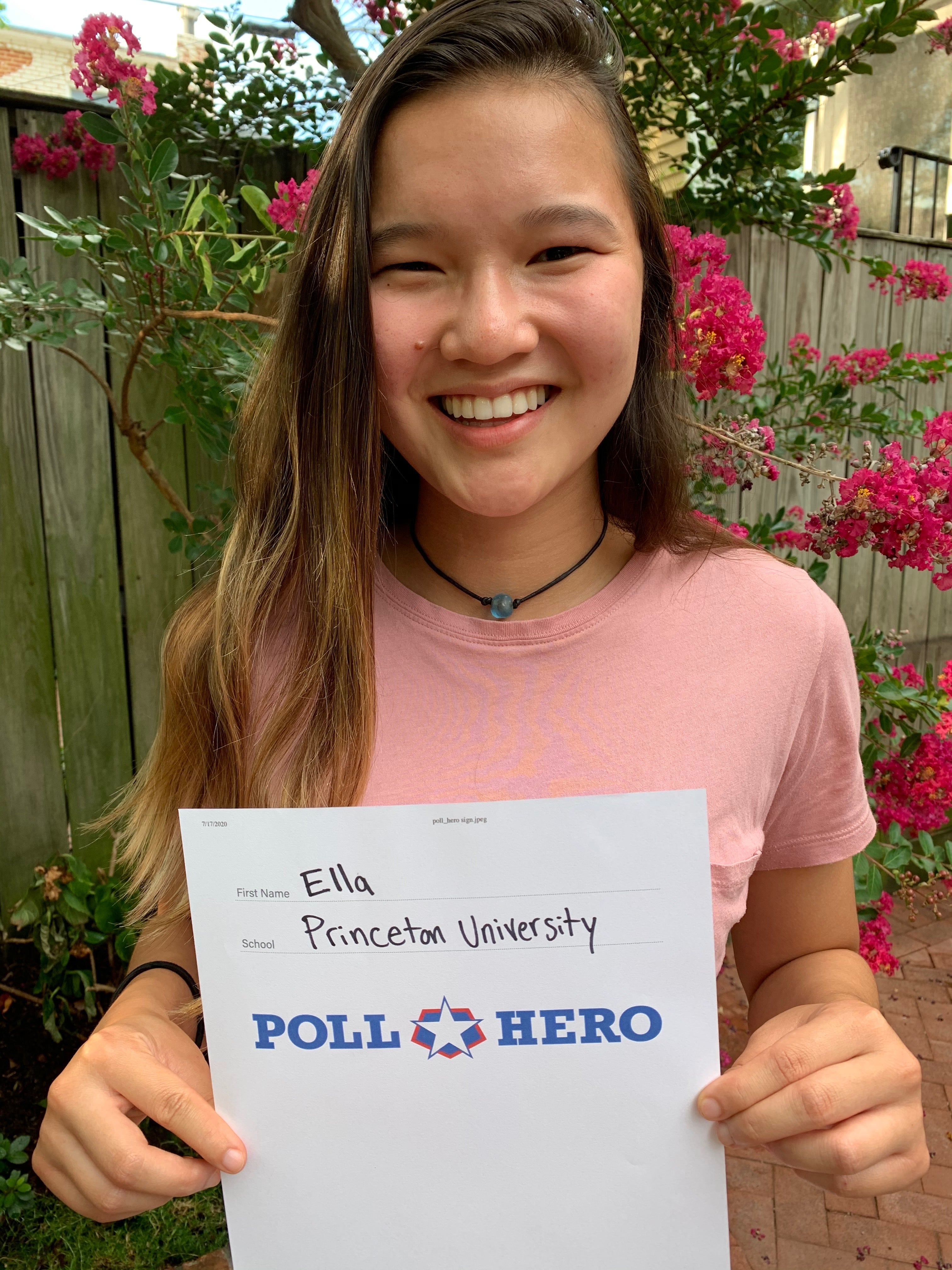Gen Z to the polls: Why young people are signing up to work 2020 elections in record numbers
Thousands of high school and college students are signing up to work the polls, and millions have already cast their ballots as the US sees an unprecedented wave in young voter turnout, Alex Woodward writes


Your support helps us to tell the story
From reproductive rights to climate change to Big Tech, The Independent is on the ground when the story is developing. Whether it's investigating the financials of Elon Musk's pro-Trump PAC or producing our latest documentary, 'The A Word', which shines a light on the American women fighting for reproductive rights, we know how important it is to parse out the facts from the messaging.
At such a critical moment in US history, we need reporters on the ground. Your donation allows us to keep sending journalists to speak to both sides of the story.
The Independent is trusted by Americans across the entire political spectrum. And unlike many other quality news outlets, we choose not to lock Americans out of our reporting and analysis with paywalls. We believe quality journalism should be available to everyone, paid for by those who can afford it.
Your support makes all the difference.Philadelphia opened just 190 polling places in its June primary, a 77 per cent drop from 831 polling sites that were open in November 2019.
During its primary elections in April, the city of Milwaukee, Wisconsin reduced its polling locations to just five – from 180. Election officials said the city didn’t have enough poll workers to keep them open.
In Bucks County, Pennsylvania, less than half of registered poll workers – 600 of 1,500 – were able to work during the state’s June primaries.
Hoping to avert similar “polling disasters” seen across the US during presidential primaries amid the coronavirus pandemic, with voters crowded into under-staffed precincts and forced to wait in hours-long lines, 19-year-old Princeton University sophomore Ella Gantman asked how she could help.
She co-founded The Poll Hero Project with a group of students from Princeton and Denver East High School and a University of Chicago Booth School of Business graduate.
The group sought to register 1,000 student poll workers within a month.
“We thought that was an ambitious goal,” she told The Independent. “What we realized quickly was we struck gold.”
Within three weeks of its launch, the group surpassed 1,500 sign-ups.
A week before Election Day on 3 November, the group has helped register more than 35,000 people to become poll workers.
Roughly 21,000 people who signed up are still in high school. Many states allow 16- and 17-year-olds to assist at the polls even if they’re not allowed to cast ballots themselves.
“At the beginning we had more volunteers than people signing up, on practically no budget,” Ms Gantman said. “We were a group of seven kids with no money who were able to do something.”
The Poll Hero Project is among several nationwide efforts to recruit young election workers to work the polls, paid or volunteer shifts typically held by older Americans to direct voters to their respective precincts, sign them in, monitor voting machines, answer questions, and review voter registries as voting ends, among other tasks.
According to the US Election Assistance Commission, nearly 60 per cent of poll workers deployed during midterm elections in 2018 were aged 61 and older, a higher-risk age group for more serious complications from Covid-19 infections.
In 2016, more than 910,000 poll workers across the US were stationed at voting precincts. Eighty-five per cent were over the age of 60.
Federal election officials in 2018 reported that 70 per cent of voting districts had difficulty recruiting poll workers that year.
Power the Polls sought to sign up 250,000 healthy, low-risk Americans to work the polls.
A week before Election Day, the group reached 700,000. More than half are under 40 years old.
Voting advocacy groups fear long wait times and reports of struggling polls could suppress votes, by turning voters away and diminishing turnout amid a high-stakes presidential election and crucial local and state elections across the US still in the grip of the public health crisis.
Nearly 21,000 Election Day polling locations have closed ahead of 2020 presidential elections, down from previous presidential election cycles in 2016 and 2012, according to an analysis from VICE News, which found widespread closures as districts endure coronavirus-related closures, cost-cutting measures and legislated voter suppression.

Poll closures and long wait times disproportionately impact Black and Latino voters compared to white voters, several analyses have found.
“In the past, long wait times were disruptive and disenfranchising. In the middle of a pandemic, they could also be deadly,” according to a report from The Brennan Center for Justice at the New York University School of Law.
In its 2020 report, the Brennan Center found that more than 6 per cent of Latino voters and 7 per cent of Black voters reported waiting 30 minutes or longer to vote, surpassing the acceptable threshold for wait times set by the Presidential Commission on Election Administration.
That figure falls to 4.1 per cent among white voters.
More generally, Latino voters waited on average 46 per cent longer than white voters, and Black voters waited on average 45 per cent longer than white voters, according to the report.
Counties that became less white over the past decade also had fewer election resources than whiter counterparts – the average county where the white population grew had 63 voters per poll worker and roughly 390 voters per polling place, the Brennan Center found.
But the average county that became less white had 80 voters per worker and 550 voters per polling place.
The Poll Hero Project has placed at least one poll worker in each state. But the group has helped register hundreds of people to work polls in battleground states that could be critical to the outcome of the presidential election.
More than 2,500 young people signed up to work the polls in Pennsylvania and Texas, and more than 1,000 young people signed up in Ohio and nearly 2,000 signed up in Florida, the group reported.
Nearly 1,000 others have signed up in Georgia.
“Those are the battleground states and the most contentious, and for us to have a fair and free Democratic process, all the polling locations need to be open in each of those states,” Ms Gantman said.
“Most [volunteers] cannot vote yet but want to be engaged with the election,” she said. “Voting is a habit. That’s why older people are more likely to vote. … What happens when you’re 16? If you’re creating that habit before you can even vote, the likelihood you can vote is going to be so much higher.”
The surge in civically engaged young Americans glimpses the momentum among younger voters in 2020 elections.
In a recent nationwide poll from the Institute of Politics at Harvard Kennedy School, 63 per cent of 18- to 29-year-old respondents will “definitely be voting” – the highest response rate in the survey’s 20-year history.
Young voters are motivated by issues surrounding healthcare access (72 per cent), particularly mental health (75 per cent), as well as racial justice (71 per cent), according to the Harvard poll.
More than five million young people between ages 18 and 29 have already cast their ballots in 2020 elections, including nearly 3 million young people in 14 key states that could effectively determine the fates of the presidency and US Senate.
An analysis from the Center for Information and Research on Civic Learning & Engagement, a nonpartisan research organisation focused on youth civic engagement, found that young voters in Florida between the ages of 18 and 29 requested more than 815,000 ballots, whether by mail or in-person during early voting, as of 23 October. That turnout is nearly triple the number of ballots from a similar point in 2016 elections.
Young voters in Texas have already cast more than 750,000 early votes. At a similar point in 2016, that figure was at just 106,000.
In Arizona, young people have requested more than 580,000 ballots – more than double the ballots requested at a similar point in 2016.
Early votes among young people are trending similarly in battleground states Georgia and Michigan as well as Virginia, Montana and Maine, the organisation found.
Once aspiring poll workers and volunteers sign up on the group’s website, they’ll receive a text from a member of the organisation to connect them with their local board of elections and help them with paperwork.
The groups have relied on social media to spread the word – thousands of people follow poll worker groups on Instagram, Twitter and Tik Tok, a generational shift from the days of in-person canvassing.
“There is a new way to reach out to Gen Z, a new way to mobilise Gen Z, and it’s not necessarily through email or phone banking,” Ms Gantman said. “We’re engaging them where they’re at.”
Between elections, the group will help combat misinformation on social media and share stories from young people about their experience at the polls.
“We were born out of realising something wasn’t working and finding out what will work,” Ms Gantman said. “After the election, it’s not over for us. We don’t want to just throw it all away on 4 November.”




Join our commenting forum
Join thought-provoking conversations, follow other Independent readers and see their replies
Comments